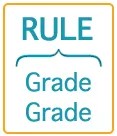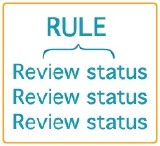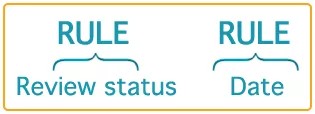Two ways to release content
When you customize the release of content, you create a course that's more interactive and tailored to the needs of individual students. In the Original Course View, you can use adaptive release to show the appropriate content, to select individuals, at the appropriate time.
You can use two types of adaptive release:
With basic adaptive release, you can apply one rule to a content item. This rule can contain all four types of criteria, but not multiple instances of the same type. All criteria in the rule must be satisfied before the item is released. The more criteria added to a rule, the more restrictions on the release of that item. More criteria make it more difficult for students to gain access.
With advanced adaptive release, you can set more complex release criteria. For example, you can add more criteria to a rule, or you can specify different options for releasing the content. Students must meet all of the criteria of one of the rules to gain access.
For example, one rule allows Group A members with a score above an 85 on a test to view the content item. Another rule for the same item allows Group B members to view the same content item only after a specific date.
You can only add one membership criterion and one date criterion for each rule. You can add multiple Grade Center and review status criteria to each rule.
Rules and criteria
Criteria are the parts that define an adaptive release rule. You can apply one or more criteria for each rule. For example, one rule may make content available after a specific date. Another rule, with multiple criteria, may make content available to a course group after a specific date.
You can add four types of criteria when you create rules:
- Date
- Membership
- Grade
- Review Status
Release content based on multiple grade columns
You have advanced readings for students who receive 85% or more on both their first term assignments and their midterm exams. You can set up a rule that includes grade criteria for both items. The path to this content is narrower because both criteria must be satisfied.
Release content when students have reviewed multiple content items
Make a unit test available when students review the three content items in the unit. Add three review status criteria, one for each content item. The path to this content is narrower because students must satisfy all three criteria for the rule.
Add two or more rules to the same content item
Make a content item available to all students in Week 5, and available sooner to students who mark all previous content items as reviewed. Add one rule with review status criterion and a second rule with date criterion. Students can take two paths to gain access to the content item because they only have to satisfy one rule.
Release content on two dates or date ranges
If you want to make a study guide available the week before both the midterm and final exams, add two date rules, one for each week. You create two paths to the same content item, controlled by date.
Releasing content in action
Three professors discuss the different ways they use release content in their courses.
Shelby M.
"I organize my course into units that correspond to textbook chapters.
I don't want students to work ahead, so I set each unit to be released on a specific date. For example, Unit 1 is ready to open when the term starts. Students can't open Unit 2 until the next week."
Maria R.
"I create additional course materials for remedial purposes. I want this material to be ready for students who need extra help in my course.
Students who received a grade of 65% or lower on their midterm exams can open the remedial material."
Tom K.
"My course is organized into weekly folders. Each folder contains an overview, a discussion, required reading, and a test.
I want students to read the material before they can open the quiz. I use adaptive release so that students need to mark the reading as reviewed before they take the quiz."







